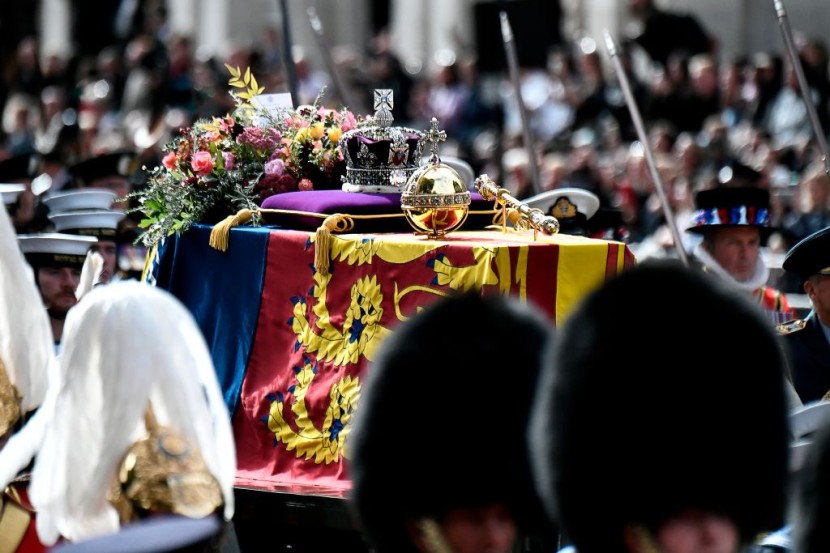
The coffin of Queen Elizabeth II has been lowered into the Royal Vault at St. George's Chapel, following a commital service.
Later on Monday, a private funeral ceremony will be conducted for the Royal Family.
Queen Elizaebeth II's funeral traveled through a line of well-wishers as it left London for the English countryside that she adored, who threw flowers, cheered, and applauded as it passed, Reuters reported.
In a fitting homage to Britain's longest-reigning monarch, who earned respect across the world during his 70 years on the throne, thousands more people poured into the city to see the parade and funeral.
Approximately 500 presidents, prime ministers, members of other royal families, and dignitaries, including Joe Biden of the United States, were present among the 2,000 mourners inside the magnificent Westminster Abbey where the burial was placed.
Following her interment, the focus shifted to St. George's Chapel at Windsor Castle, where over 800 people attended a committal service.
The Instruments of State; the Imperial State Crown and the Orb and Sceptre have remained with Her Majesty’s coffin.
— The Royal Family (@RoyalFamily) September 19, 2022
At the Committal Service, they were placed on the
High Altar at St George's Chapel. pic.twitter.com/fDFQLSSmP1
The ritual ends with the removal of the monarch's authority and governing symbols-the crown, orb, and scepter-from the coffin and placement on the altar.
The most senior member of the royal household, the Lord Chamberlain, then breaks his "Wand of Office," denoting the conclusion of his duty to the monarch, and sets it on the coffin.
The coffin of Elizabeth and her late husband, Prince Philip, who passed away last year at the age of 99, would be interred together in the chapel where her parents and sister, Princess Margaret, are also laid to rest later in the evening at a special family ceremony.
A Day of Mourning for Britain and the World
The deep sorrow was felt by so many people in Britain and across the world during the late monarch's funeral, according to Archbishop of Canterbury Justin Welby, was a reflection of her rich life and loving service.
Her Majesty The Queen’s coffin makes its final journey down the Long Walk to Windsor Castle for the Committal Service at St George's Chapel. pic.twitter.com/vqczfMENlM
— The Royal Family (@RoyalFamily) September 19, 2022
He noted that during a program commemorating her 21st birthday, "Her late majesty famously declared that her whole life would be "dedicated to serving the nation and Commonwealth."
The same tunes that played at the queen's marriage in 1947 and coronation six years later resounded. Scripture passages were sung to a soundtrack that has been utilized at every state burial since the early 18th century accompanied the coffin's entrance.
Thousands of members of the armed services in ceremonial finery participated in one of the greatest military processions ever seen in Britain as they dragged her flag-draped casket through the streets of London after the funeral.
They moved in unison as marching bands played funeral music and the city's iconic Big Ben chimed each minute in the distance. Senior royals including King Charles followed on foot.
A hearse was used to transport the casket from Westminster Abbey to Wellington Arch and then on to Windsor, where sizable crowds waited expectantly.
Royal Family Members Pay Respects
King Charles III participated in the transfer of Queen Elizabeth II's body from the Quadrangle at Windsor Castle to St. George's Chapel.
Princess Anne, Prince Andrew, Prince Edward, Prince William, and Prince Harry followed His Majesty on foot.
Princess Charlotte, the great-granddaughter of Queen Elizabeth II, was ostensibly seen sobbing during Her Majesty's burial procession per Fox News.
During the ending of the committal service for Queen Elizabeth II at St. George's Chapel in Windsor Castle, an emotional King Charles III listened to the singing of the British national anthem, according to a CNN report.
Following the committal service, King Charles III and Camilla, the Queen Consort, departed from the chapel.
Before being transported away, they paused to express their gratitude to the Dean and persons involved in the service.
The rest of the family members followed the couple.
© 2025 HNGN, All rights reserved. Do not reproduce without permission.








